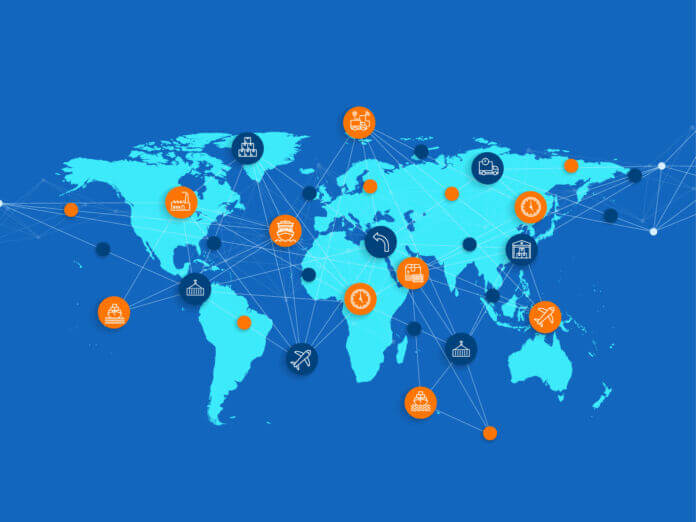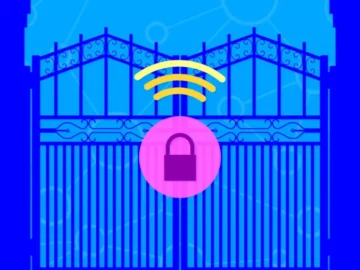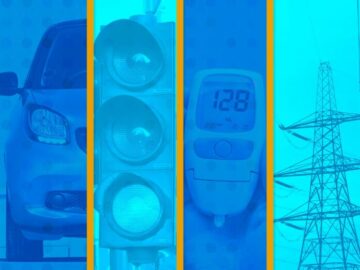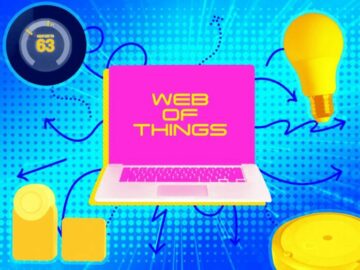
Likely, you’re already using IoT to improve visibility in your delivery fleet and for increased supply chain optimization. By 2023, nearly 70 percent of logistics providers were. If so, you’ve got a steady stream of data telling you where your assets are.
Maybe you have some condition monitoring, too, like temperature readings for refrigerated cargo. Maybe you even have geofencing set up around your distribution centers or depots. In other words: You’ve got the data. But what do you do with it?
The truth is that a single source of data can’t tell you much about your operation on the ground. To get real, actionable insights, you need integrated data, and you need it in time to act.
Many of today’s logistics IoT platforms fall short of these two essential capabilities. Logistics actors need automatic data integration and AI processing in real time. Here’s why.
Challenge #1: Most Logistics Apps Don’t Integrate Data Well
With your current system, odds are each data source—sensor, GPS tag, third-party reporting, etc.—feeds into a separate database.
- Geospatial location data comes from the IoT or GPS devices.
- Shipment information might be in a vendor’s product database.
- Environmental conditions, from traffic events to the weather, are updated in institutional databases maintained by local government entities.
- Every software as a service (SaaS) you integrate with keeps its database.
If it is kept separate, how can all this disparate information help you reroute a shipment to avoid late fees with the clock ticking? Or choose a new shipping lane when you’ve got fresh reports of piracy in one area, and a gathering storm in another? Or simply tell whether your asset utilization is trending toward waste?
To make the decision that changes everything, you need multiple data streams combined into a single data model. You need a 360-degree view of real-world conditions. That is what data integration provides, and why it is the missing ingredient in too many logistics platforms.
But wait, you might say. We join databases all the time. Indeed, database joins can integrate IoT, status, and location data. But by the time that data integration is complete, it may be too late to avert disaster. This issue of timing leads us to the second flaw in today’s logistics IoT platforms.
Challenge 2: Batch Updates Can’t Solve Problems
Logistics actors often need operational analytics that work in real time, or as close to real time as you can get. Of course, this kind of data analytics is impossible. Our brains may take 100 milliseconds or more to process visual input. If we’re not even seeing it in real time, how can we expect to get organized, integrated IoT data without a bit of lag?
The realistic goal is functional real time. Generally, for logistics and supply chain use cases, functional real-time data reaches you in a few milliseconds or as many as three minutes. Consider three minutes or less your goal for real-time IoT analytics. That’s plenty of time to act for most logistics’ scenarios.
Given the realities of IoT battery life, batch updates can’t approach functional real time. That doesn’t mean there’s no place for batch data in your IoT pipeline; ideally, you could rely on both batch and streaming data, depending on the use case.
Unfortunately, many of today’s IoT data stacks can’t switch from batch to streaming easily. Instead, look for a data-streaming engine that processes data with machine learning—and supports both batch and streaming updates.
Such a solution solves the challenges of data integration and timing at once. It delivers powerful—meaning actionable—insights for logistics and supply chain operators. It might even change the way you think about supply chain optimization.
Improve Data Integration in Existing Logistics IoT
Most of the IoT devices currently deployed in the logistics industry are starting to get old. They are likely built for energy efficiency and affordability, not complex data generation. The data they send is unlikely to be well-organized or well-structured and will not lead to supply chain optimization.
These data-processing deficits can lead to inconsistent data. (Data consistency means the value will remain correct and valid across instances. If it appears on two servers, for instance, it will be the same on both.) Poorly processed IoT data may also show up out of order, leading to errors.
However, replacing older IoT devices would be unthinkably expensive. Luckily, it is possible to build a business intelligence (BI) platform with strong data integration and real-time reporting with your existing IoT fleet. You just need a better pipeline.
Look for an event-processing engine that combines three capabilities:
- Functional real-time streaming data.
- Easy data integration and dynamic updating.
- Contextual understanding with real-time machine learning.
You can use such a tool to build data pipelines within your existing BI systems. Or you can use it as an all-in-one logistics app, complete with the user interface. Either way, you’re relying on the engine’s data processing powers, so you don’t have to replace your devices.
Instead, replace your whole analytics paradigm. Current supply chain technology tends to be organized around measurements: The trailer is here. The temperature is X. Fuel consumption is Y. Let’s query each value in turn.
There is a more useful way to interact with data: Approach them not as discrete measurements but as combined processes. This process view leads to actionable insight much faster.
Supply Chain Example
Say you’re tracking a refrigerated truck carrying a million-dollar shipment of vaccines. If the temperature rises too much, for too long, the whole shipment will be lost. Now say your temperature sensors register an anomaly: The cooling unit has failed. You have maybe two hours to save the load (and, potentially, your business).
With a real-time, streaming data platform, geospatial data tells you whether there’s a nearby reefer trailer that could come to the rescue. Condition monitoring tells you whether the refrigerator’s power supply is the problem, while contextual data suggests a likely repair time.
With this integrated data, you can decide the best way to save the shipment. And you can do so in time to execute your plan. That’s the power of data integration within a real-time intelligence platform.
Logistics and Supply Chain Optimization
IoT is indeed transforming the logistics and supply chain optimization. But it is not exactly true that data is the key. To truly optimize your supply chain, data alone is not enough. You need data integration processed in functional real time.
- SEO Powered Content & PR Distribution. Get Amplified Today.
- PlatoData.Network Vertical Generative Ai. Empower Yourself. Access Here.
- PlatoAiStream. Web3 Intelligence. Knowledge Amplified. Access Here.
- PlatoESG. Carbon, CleanTech, Energy, Environment, Solar, Waste Management. Access Here.
- PlatoHealth. Biotech and Clinical Trials Intelligence. Access Here.
- Source: https://www.iotforall.com/supply-chain-optimization-with-integrated-iot-data
- :has
- :is
- :not
- :where
- $UP
- 1
- 2%
- 2023
- 360-degree
- a
- About
- across
- Act
- actionable
- actors
- AI
- All
- all-in-one
- alone
- already
- also
- an
- analytics
- and
- Another
- app
- appears
- approach
- apps
- ARE
- AREA
- around
- AS
- Assets
- At
- Automatic
- avert
- avoid
- battery
- Battery life
- BE
- BEST
- Better
- Bit
- both
- brains
- build
- built
- business
- business intelligence
- but
- by
- CAN
- Can Get
- capabilities
- Cargo
- carrying
- case
- cases
- Centers
- chain
- challenges
- change
- Changes
- Choose
- Clock
- Close
- combined
- combines
- come
- comes
- complete
- complex
- condition
- conditions
- Consider
- consumption
- contextual
- correct
- could
- course
- Current
- Currently
- data
- Data Analytics
- data integration
- Data Platform
- data processing
- Database
- databases
- decide
- decision
- delivers
- delivery
- Depending
- deployed
- Devices
- disaster
- discrete
- disparate
- distribution
- do
- Doesn’t
- Dont
- dynamic
- each
- easily
- efficiency
- either
- energy
- energy efficiency
- Engine
- enough
- entities
- Errors
- essential
- etc
- Even
- events
- everything
- exactly
- execute
- existing
- expect
- expensive
- Failed
- Fall
- faster
- Fees
- few
- flaw
- FLEET
- For
- fresh
- from
- Fuel
- functional
- gathering
- generally
- generation
- get
- goal
- got
- Government
- Government Entities
- gps
- Ground
- Have
- help
- here
- HOURS
- How
- HTTPS
- ideally
- if
- impossible
- improve
- in
- In other
- inconsistent
- increased
- indeed
- industry
- information
- ingredient
- input
- insight
- insights
- instance
- instances
- instead
- Institutional
- integrate
- integrated
- integration
- Intelligence
- interact
- Interface
- into
- iot
- iot devices
- issue
- IT
- ITS
- join
- Joins
- jpg
- just
- kept
- Key
- Kind
- Lane
- Late
- lead
- leading
- Leads
- learning
- less
- Life
- like
- likely
- load
- local
- Local Government
- location
- logistics
- Long
- Look
- lost
- machine
- machine learning
- maintained
- make
- many
- max-width
- May..
- maybe
- McKinsey
- mean
- means
- measurements
- might
- milliseconds
- minutes
- missing
- model
- monitoring
- more
- most
- much
- multiple
- Need
- New
- no
- now
- Odds
- of
- often
- Old
- older
- on
- once
- ONE
- operation
- operational
- operators
- optimization
- Optimize
- or
- Organized
- Other
- our
- paradigm
- pipeline
- Piracy
- Place
- plan
- platform
- Platforms
- plato
- Plato Data Intelligence
- PlatoData
- Plenty
- possible
- potentially
- power
- Power Supply
- powers
- Problem
- process
- processed
- processes
- processing
- Product
- providers
- provides
- query
- Reaches
- real
- real world
- real-time
- real-time data
- realistic
- realities
- register
- rely
- relying
- remain
- repair
- replace
- Reporting
- Reports
- rescue
- Rises
- SaaS
- same
- Save
- say
- scenarios
- Second
- send
- sensors
- separate
- Servers
- service
- set
- Shipping
- Short
- show
- simply
- single
- So
- Software
- software as a service
- solution
- SOLVE
- Solves
- some
- Source
- Stacks
- stanford
- Starting
- Status
- steady
- Storm
- stream
- streaming
- strong
- such
- Suggests
- supply
- supply chain
- Supply Chain Optimization
- Supports
- Switch
- system
- Systems
- Technology
- tell
- telling
- tells
- tends
- that
- The
- Them
- These
- they
- Think
- third-party
- this
- three
- ticking
- time
- timing
- to
- today’s
- too
- tool
- toward
- Tracking
- traffic
- trailer
- transforming
- trending
- truck
- true
- truly
- truth
- TURN
- two
- understanding
- unit
- unlikely
- updated
- Updates
- updating
- us
- use
- use case
- useful
- User
- User Interface
- using
- vaccines
- valid
- value
- View
- visibility
- visual
- Waste
- Way..
- we
- Weather
- were
- What
- when
- whether
- while
- whole
- why
- will
- with
- within
- without
- words
- Work
- would
- X
- you
- Your
- zephyrnet











